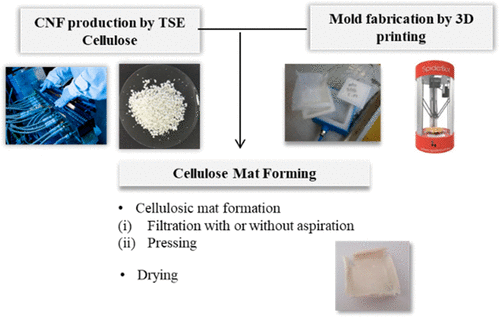当前位置:
X-MOL 学术
›
Ind. Eng. Chem. Res.
›
论文详情
Our official English website, www.x-mol.net, welcomes your
feedback! (Note: you will need to create a separate account there.)
Production of 100% Cellulose Nanofibril Objects Using the Molded Cellulose Process: A Feasibility Study
Industrial & Engineering Chemistry Research ( IF 3.8 ) Pub Date : 2020-02-21 , DOI: 10.1021/acs.iecr.9b06127 Fleur Rol 1 , Marie Billot 1 , Marco Bolloli 1 , Davide Beneventi 1 , Julien Bras 1, 2
Industrial & Engineering Chemistry Research ( IF 3.8 ) Pub Date : 2020-02-21 , DOI: 10.1021/acs.iecr.9b06127 Fleur Rol 1 , Marie Billot 1 , Marco Bolloli 1 , Davide Beneventi 1 , Julien Bras 1, 2
Affiliation

|
High barrier and mechanically resistant three-dimensional (3D) cellulosic objects were produced using cellulose nanofibrils (CNF) and the molded cellulose process. The main objective is to improve properties of objects made by molding conventional papermaking fibers such as egg box. This well-known process, currently used for the production of low-end cellulose packaging, was simulated using 3D-printed polycarbonate porous molds, dewatering, and heat compression stages. CNF produced by twin screw extrusion, which possess good barrier properties and transparency, were used as the base material, and different methods were used to form the cellulosic mats. Different drying techniques were tested in order to produce a transparent object and minimize the shrinkage of CNF upon drying, that is, oven-drying, thermo-pressing, microwave-drying, freeze-drying, or a combination. CNF cellulosic mats were easily formed, but due to the important shrinkage of CNF, none of the mat formation or drying techniques yielded transparent and dimensionally stable 3D objects.
中文翻译:

使用模制纤维素工艺生产100%纤维素纳米原纤维物体的可行性研究
使用纤维素纳米原纤维(CNF)和模制纤维素工艺生产了具有高阻隔性和机械抵抗力的三维(3D)纤维素物体。主要目的是改善通过模制常规造纸纤维如蛋盒制成的物体的性能。使用3D打印的聚碳酸酯多孔模具,脱水和热压缩阶段对当前用于生产低端纤维素包装的这一众所周知的过程进行了模拟。具有良好的阻隔性和透明性的通过双螺杆挤出生产的CNF被用作基础材料,并且使用了不同的方法来形成纤维素垫。为了生产透明物体并最大程度减少干燥时CNF的收缩,已测试了不同的干燥技术,即烤箱干燥,热压,微波干燥,冷冻干燥或两者结合。CNF纤维素垫很容易形成,但是由于CNF的重要收缩,垫的形成或干燥技术均无法产生透明且尺寸稳定的3D对象。
更新日期:2020-02-21
中文翻译:

使用模制纤维素工艺生产100%纤维素纳米原纤维物体的可行性研究
使用纤维素纳米原纤维(CNF)和模制纤维素工艺生产了具有高阻隔性和机械抵抗力的三维(3D)纤维素物体。主要目的是改善通过模制常规造纸纤维如蛋盒制成的物体的性能。使用3D打印的聚碳酸酯多孔模具,脱水和热压缩阶段对当前用于生产低端纤维素包装的这一众所周知的过程进行了模拟。具有良好的阻隔性和透明性的通过双螺杆挤出生产的CNF被用作基础材料,并且使用了不同的方法来形成纤维素垫。为了生产透明物体并最大程度减少干燥时CNF的收缩,已测试了不同的干燥技术,即烤箱干燥,热压,微波干燥,冷冻干燥或两者结合。CNF纤维素垫很容易形成,但是由于CNF的重要收缩,垫的形成或干燥技术均无法产生透明且尺寸稳定的3D对象。











































 京公网安备 11010802027423号
京公网安备 11010802027423号